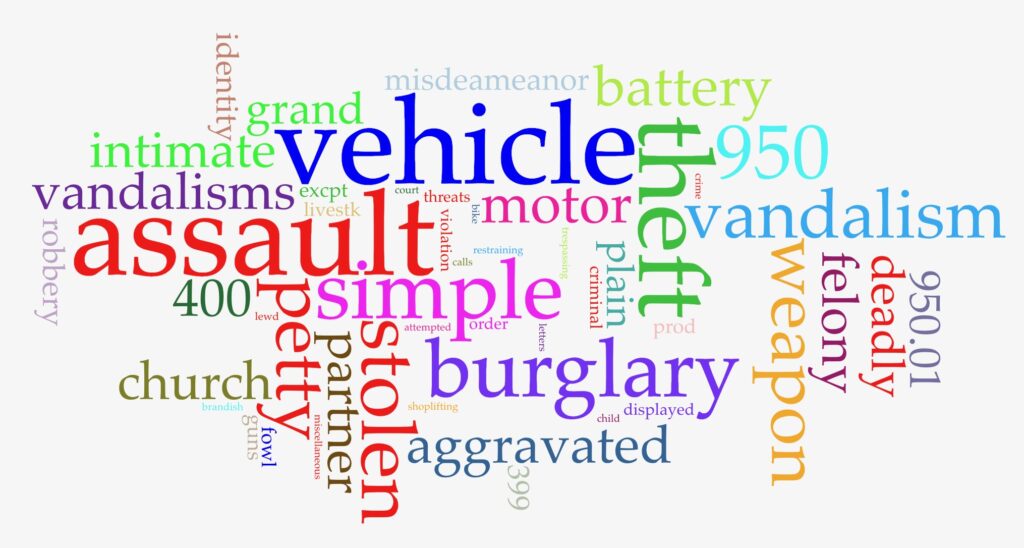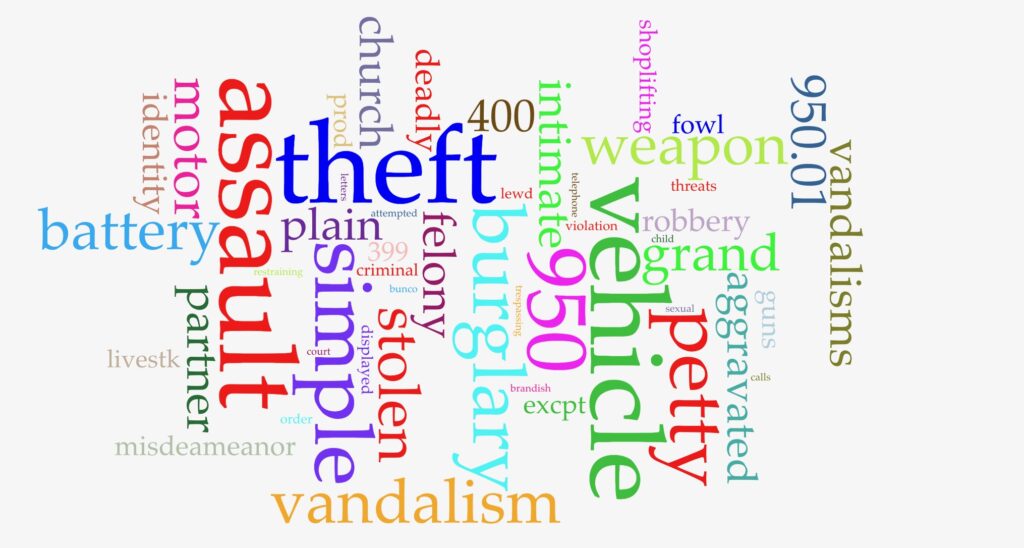The COVID-19 pandemic has ignited extensive discussions and debates regarding its potential impact on crime rates, not just in Los Angeles but in cities worldwide. Understanding the intricate relationship between the pandemic and crime is of utmost importance for policymakers, law enforcement agencies, and communities as they strive to develop effective strategies and interventions. In this research analysis, we aim to delve deeper into the specific types of crimes that experienced fluctuations during the pandemic in Los Angeles, while also examining the categories that remained relatively stable. To accomplish this, we draw from significant findings and insights gleaned from previous studies conducted by experts in the field.
To initiate our analysis, we meticulously compiled a comprehensive dataset of crime types and generated word cloud graphs based on the frequency of each recorded crime. By visually representing the occurrence of various crime types, these graphs provided us with a snapshot of the major categories that persisted before and after the COVID-19 outbreak. Notably, we observed a consistent presence of crimes such as assault, vehicle-related offenses, theft, and burglary. However, to gain a more nuanced understanding, we embarked on a quest to investigate whether dividing these major crime types into more specific subcategories would yield distinct patterns. In order to achieve this, we embarked on an extensive review of external sources, including research papers, official reports, and academic journals, to enhance the comprehensiveness of our analysis.

Data collected from January 1, 2020 to March 1, 2023

Data collected from March 13, 2020 (when LA went on lockdown) to July 1, 2020
Impact on Gang-Related Crime
One critical aspect we explored was the impact of the pandemic on gang-related crime in Los Angeles. Initially, there were concerns that the social and cultural stressors precipitated by the pandemic might result in an upsurge of gang-related activities. However, research conducted by esteemed criminologists and sociologists (Jeffery Brantingham, 2021) suggests that gang-related crime rates in Los Angeles remained relatively stable during the pandemic. This intriguing finding implies that the factors influencing these crimes are likely more complex and multifaceted, extending beyond the direct impact of the pandemic itself. Deeper investigation and research into these underlying factors will be crucial for policymakers and law enforcement agencies seeking to effectively address and mitigate gang-related crimes.
Rise in Domestic Violence
Another significant finding that emerged from our review of previous studies centered around the rise in domestic violence incidents during the pandemic. Multiple researchers and organizations have highlighted a substantial increase in such cases, with incidents frequently involving the use of weapons and occurring in public places (Miller, 2020). These disturbing trends indicate a direct link between COVID-19 regulations and the escalation of domestic violence. The stressors arising from factors such as financial strain, social isolation, and disrupted support systems have compounded the existing vulnerabilities, leading to a surge in intimate partner violence. This sobering revelation emphasizes the urgent need for comprehensive intervention strategies to address and prevent domestic violence during and beyond the pandemic.
Overall Crime Rates
Examining the overall crime rates in Los Angeles during the pandemic, we discovered an intriguing pattern. The initial implementation of COVID-19 containment policies, including stay-at-home orders and restrictions on public gatherings, seemingly resulted in a temporary decline in instrumental and serious crimes. However, as the pandemic progressed and restrictions were gradually lifted, crime rates rebounded and eventually returned to pre-pandemic levels (Campedelli et al., 2021). This observation suggests that the long-term impact of COVID-19 regulations on overall crime rates in Los Angeles was relatively limited. While the initial decrease in crime rates can be attributed to the disruption of regular routines and decreased opportunities for criminal activities, it is essential to recognize that the underlying drivers of crime remain complex and multifaceted. Policymakers and law enforcement agencies must consider a holistic approach that addresses the root causes of criminal behavior to sustainably reduce crime rates beyond the pandemic.
Synthesizing the findings from previous research, it becomes evident that the impact of the COVID-19 pandemic on crime rates in Los Angeles is multifaceted. Gang-related crime, despite initial concerns, remained relatively stable, indicating the presence of factors unrelated to the pandemic. Conversely, domestic violence experienced a significant increase, highlighting a direct correlation between COVID-19 regulations and this specific type of crime. Although overall crime rates initially declined, they eventually returned to pre-pandemic levels, suggesting a limited long-term influence of COVID-19 regulations on crime rates.
Building upon the insights gleaned from these research findings, we revisited our crime type analysis within our dataset, with a specific focus on intimate partner assault. By isolating this specific type of crime and examining its occurrence throughout the pandemic, we uncovered a clear increase in incidents following the implementation of stay-at-home policies, aligning closely with existing research findings. This finding underscores the vulnerability of individuals in abusive relationships during times of crisis and highlights the need for robust support systems, accessible resources, and proactive measures to protect victims and survivors of domestic violence.
In conclusion, this comprehensive analysis underscores the diverse effects of the COVID-19 pandemic on crime rates in Los Angeles. Understanding these patterns is crucial for policymakers and law enforcement agencies in formulating targeted strategies to address the challenges posed by the pandemic. By adopting evidence-based approaches, communities can work towards fostering safety and security in the face of evolving circumstances.